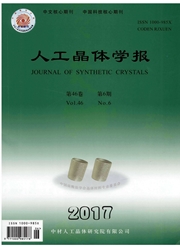

 中文摘要:
中文摘要:
以Bi(NO3)3·5H2O为原料,乙二醇(ethylene glycol,EG)为溶剂,采用水解法,在不同沉淀剂(NH3·H2O,Na2CO3和CO(NH2)2)条件下制备了Bi OCl光催化剂。使用X射线衍射(XRD)、扫描电镜(SEM)、N2物理吸附、紫外可见漫反射(DRS)、光致发光(PL)光谱等手段对所制样品进行了表征。以甲基橙染料为降解物,评价了不同沉淀条件对Bi OCl光催化性能的影响。结果表明,不同沉淀条件对Bi OCl光催化剂的结晶度、晶粒尺寸、形貌、禁带宽度、光生电子空穴对分离效率有明显的影响,进而影响了其光催化活性。其中以尿素为沉淀剂制得的催化剂Bi OCl-3在模拟太阳光下降解甲基橙(MO)实验中显示了良好的光催化效率,光照60 min后对MO的降解效率达97%。Bi OCl-3较高的光催化活性是由于其具有较高的结晶度、均匀的片状结构、较窄的带隙(2.9 e V)和较高的光生电子-空穴对分离效率。自由基和空穴捕获实验证明,光生空穴是Bi OCl-3光催化反应体系中的主要活性物种。此外,所制备的Bi OCl-3光催化剂具有较高的光催化稳定性,重复使用4次后对甲基橙的降解率仍保持在89%以上。
 英文摘要:
英文摘要:
A series of BiOC1 photocatalysts were prepared with the material of Bi( NO3 )3 · 5H20 and ethylene glycol solvent using different precipitants ( NH3 · H20, Na2CO3 and CO ( NH2 ) 2 ) by a simple hydrolysis method. The obtained BiOC1 samples were characterized by powder X-ray diffraction (XRD) , scanning electron microscopy (SEM) , N2 physical adsorption, UV-Vis diffuse reflectance spectroscopy (DRS) and photolumineseence (PL) emission spectroscopy. The photocatalytie activity of the as- prepared samples were evaluated by photoeatalytic degradation of methyl orange. It was found that precipitants can influence the erystallinity, grain size, morphology, band gap and the separation of electron-hole pairs, which further determines their specific photocatalytic performances. The as- synthesized BiOC1-3 using urea as precipitant exhibits high photoeatalytic efficiency towards the degradation of methyl orange (MO) under simulated solar irradiation. MO is nearly completely eliminated with a photocatalytic degradation rate of 97% after 60 min irradiation. The enhanced photocatalytic activities could be attributed to the higher crystallinity, narrow band gap and separation of electron-holepairs. Radicals and holes the practical application of 89% for MO after ion trapping experiments show that h + is inw)lved in the photoeatalytic process. For the obtained BiOC1-3 show good stability with a photoeatalytie degradation rate cycles.
 同期刊论文项目
同期刊论文项目
 同项目期刊论文
同项目期刊论文
 Electronic structures and optical properties of transition metals (Fe, Co, Ni, Zn) doped rutile TiO2
Electronic structures and optical properties of transition metals (Fe, Co, Ni, Zn) doped rutile TiO2 Preparation and photocatalytic properties of ilmenite NiTiO3 powders for degradation of humic acid i
Preparation and photocatalytic properties of ilmenite NiTiO3 powders for degradation of humic acid i A dual chelating sol-gel synthesis of BaTiO3 nanoparticles with effective photocatalytic activity fo
A dual chelating sol-gel synthesis of BaTiO3 nanoparticles with effective photocatalytic activity fo First-principles investigation of impurity concentration influence on bonding behavior, electronic s
First-principles investigation of impurity concentration influence on bonding behavior, electronic s First-principles study on the structural, electronic and optical properties of BiOX (X=Cl, Br, I) cr
First-principles study on the structural, electronic and optical properties of BiOX (X=Cl, Br, I) cr Low temperature one-step synthesis of rutile TiO2/BiOCl composites with enhanced photocatalytic acti
Low temperature one-step synthesis of rutile TiO2/BiOCl composites with enhanced photocatalytic acti Facile preparation of Sn-doped BiOCl photocatalyst with enhanced photocatalytic activity for benzoic
Facile preparation of Sn-doped BiOCl photocatalyst with enhanced photocatalytic activity for benzoic DFT+U predictions: The effect of oxygen vacancy on the structural, electronic and photocatalytic pro
DFT+U predictions: The effect of oxygen vacancy on the structural, electronic and photocatalytic pro Synthesis of BiOCl photocatalyst by a low-cost, simple hydrolytic technique and its excellent photoc
Synthesis of BiOCl photocatalyst by a low-cost, simple hydrolytic technique and its excellent photoc Effect of light response on the photocatalytic activity of BiOCl (x) Br1-x in the removal of Rhodami
Effect of light response on the photocatalytic activity of BiOCl (x) Br1-x in the removal of Rhodami One-step synthesis of porous BiOBrfilm and Bi nanopowder simultaneously from Bi plate via electroche
One-step synthesis of porous BiOBrfilm and Bi nanopowder simultaneously from Bi plate via electroche Photocatalytic degradation of carbamazepine using hierarchical BiOClmicrospheres: Some key operating
Photocatalytic degradation of carbamazepine using hierarchical BiOClmicrospheres: Some key operating Effect of chlorine ion on the crystalline and photocatalytic activityof BiOCl for the degradation of
Effect of chlorine ion on the crystalline and photocatalytic activityof BiOCl for the degradation of An in vitro study on the cytotoxicity of bismuth oxychloride nanosheets in human HaCaT keratinocytes
An in vitro study on the cytotoxicity of bismuth oxychloride nanosheets in human HaCaT keratinocytes Rapid synthesis of hierarchical BiOCl microspheres for efficient photocatalytic degradation of carba
Rapid synthesis of hierarchical BiOCl microspheres for efficient photocatalytic degradation of carba A BiPO4/BiOCl heterojunction photocatalyst with enhanced electron-hole separation and excellent phot
A BiPO4/BiOCl heterojunction photocatalyst with enhanced electron-hole separation and excellent phot A facile approach for the tunable fabrication of BiOBr photocatalysts with high activity and stabili
A facile approach for the tunable fabrication of BiOBr photocatalysts with high activity and stabili One-pot hydrothermal synthesis of a novel BiPO4/BiOBrcomposite with enhanced visible light photocata
One-pot hydrothermal synthesis of a novel BiPO4/BiOBrcomposite with enhanced visible light photocata Comparative toxicities of bismuth oxybromide and titanium dioxideexposure on human skin keratinocyte
Comparative toxicities of bismuth oxybromide and titanium dioxideexposure on human skin keratinocyte Double Br sources fabrication and photocatalytic property of p-n junction BiOBr/ZnO composites for p
Double Br sources fabrication and photocatalytic property of p-n junction BiOBr/ZnO composites for p Effect of chlorine ion on the crystalline and photocatalytic activity of BiOCl for the degradation o
Effect of chlorine ion on the crystalline and photocatalytic activity of BiOCl for the degradation o RhB-sensitized effect on the enhancement of photocatalytic activity of BiOCl toward bisphenol-A unde
RhB-sensitized effect on the enhancement of photocatalytic activity of BiOCl toward bisphenol-A unde Regeneration of novel visible-light-driven Ag/Ag3PO4@C3N4 hybrid materials and their high photocatal
Regeneration of novel visible-light-driven Ag/Ag3PO4@C3N4 hybrid materials and their high photocatal Simple hydrolysis-photodeposition route to synthesize Ag/BiOCl0.5Br0.5 composites with highly enhanc
Simple hydrolysis-photodeposition route to synthesize Ag/BiOCl0.5Br0.5 composites with highly enhanc A facile approach for the tunable fabrication of BiOBr photocatalystswith high activity and stabilit
A facile approach for the tunable fabrication of BiOBr photocatalystswith high activity and stabilit 期刊信息
期刊信息
